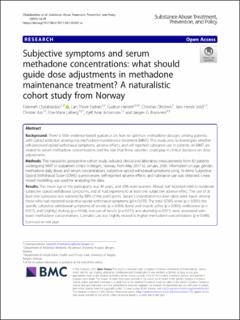| dc.contributor.author | Chalabianloo, Fatemeh | |
| dc.contributor.author | Fadnes, Lars T. | |
| dc.contributor.author | Høiseth, Gudrun | |
| dc.contributor.author | Ohldieck, Christian | |
| dc.contributor.author | Vold, Jørn Henrik | |
| dc.contributor.author | Aas, Christer Frode | |
| dc.contributor.author | Løberg, Else-Marie | |
| dc.contributor.author | Johansson, Kjell Arne | |
| dc.contributor.author | Bramness, Jørgen Gustav | |
| dc.date.accessioned | 2021-09-02T08:55:13Z | |
| dc.date.available | 2021-09-02T08:55:13Z | |
| dc.date.created | 2021-07-09T11:39:23Z | |
| dc.date.issued | 2021 | |
| dc.identifier.issn | 1747-597X | |
| dc.identifier.uri | https://hdl.handle.net/11250/2772474 | |
| dc.description.abstract | Background: There is little evidence-based guidance on how to optimize methadone dosages among patients with opioid addiction undergoing methadone maintenance treatment (MMT). This study aims to investigate whether self-perceived opioid withdrawal symptoms, adverse effects, and self-reported substance use in patients on MMT are related to serum methadone concentrations and the role that these variables could play in clinical decisions on dose adjustments.
Methods: This naturalistic prospective cohort study included clinical and laboratory measurements from 83 patients undergoing MMT in outpatient clinics in Bergen, Norway, from May 2017 to January 2020. Information on age, gender, methadone daily doses and serum concentrations, subjective opioid withdrawal symptoms using 16 items Subjective Opioid Withdrawal Scale (SOWS) questionnaire, self-reported adverse effects, and substance use was obtained. Linear mixed modelling was used for analyzing the data.
Results: The mean age of the participants was 45 years, and 33% were women. Almost half reported mild to moderate subjective opioid withdrawal symptoms, and all had experienced at least one subjective adverse effect. The use of at least one substance was reported by 88% of the participants. Serum concentration-to-dose ratios were lower among those who had reported subjective opioid withdrawal symptoms (p) = 0.039). The total SOWS score (p < 0.001); the specific subjective withdrawal symptoms of anxiety (p = 0.004), bone and muscle aches (p = 0.003), restlessness (p = 0.017), and (slightly) shaking (p = 0.046), also use of heroin (p = 0.015) and alcohol (p = 0.011) were associated with lower methadone concentrations. Cannabis use was slightly related to higher methadone concentrations (p = 0.049).
Conclusions: The findings suggest that the patient’s self-perceived symptoms and current clinical condition are related to the serum concentrations of methadone. This interpretation supports dose adjustments based on patient-reported symptoms. In some aberrant cases, measurement of serum concentrations together with other individual assessments may be considered to support the clinical decision. | en_US |
| dc.language.iso | eng | en_US |
| dc.publisher | BMC | en_US |
| dc.rights | Navngivelse 4.0 Internasjonal | * |
| dc.rights.uri | http://creativecommons.org/licenses/by/4.0/deed.no | * |
| dc.title | Subjective symptoms and serum methadone concentrations: what should guide dose adjustments in methadone maintenance treatment? A naturalistic cohort study from Norway | en_US |
| dc.type | Journal article | en_US |
| dc.type | Peer reviewed | en_US |
| dc.description.version | publishedVersion | en_US |
| dc.rights.holder | Copyright The Author(s). 2021 | en_US |
| dc.source.articlenumber | 39 | en_US |
| cristin.ispublished | true | |
| cristin.fulltext | original | |
| cristin.qualitycode | 1 | |
| dc.identifier.doi | 10.1186/s13011-021-00367-w | |
| dc.identifier.cristin | 1921152 | |
| dc.source.journal | Substance Abuse Treatment, Prevention, and Policy | en_US |
| dc.identifier.citation | Substance Abuse Treatment, Prevention, and Policy. 2021, 16, 39. | en_US |
| dc.source.volume | 16 | en_US |

